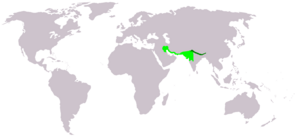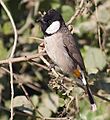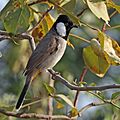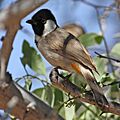White-eared bulbul facts for kids
Quick facts for kids White-eared bulbul |
|
|---|---|
 |
|
| A white-eared bulbul in Keoladeo National Park, India | |
| Conservation status | |
| Scientific classification | |
 |
|
| Where P. leucotis (light green) and P. leucogenys (dark green) live in South Asia | |
| Synonyms | |
|
The white-eared bulbul (its scientific name is Pycnonotus leucotis) is a small, cheerful bird. It belongs to a group of birds called bulbuls. You can find this bird in parts of south-western Asia, from India all the way to the Arabian Peninsula.
Contents
About the White-Eared Bulbul
Scientists first named this bird in 1836. It was given its scientific name, Pycnonotus leucotis, by a scientist named John Gould.
Bird Families and Subspecies
The white-eared bulbul is part of a special group called a superspecies. This means it is very closely related to other bulbuls. Some of its close relatives include the Himalayan bulbul and the white-spectacled bulbul.
There are two main types, or subspecies, of the white-eared bulbul:
- Arabian white-cheeked bulbul (P. l. mesopotamia): This type lives in north-eastern Arabia, southern Iraq, and south-western Iran. It was named by Claud B. Ticehurst in 1918.
- P. l. leucotis: This type is found in southern Iran, southern Afghanistan, Pakistan, and north-western India.
What the Bulbul Looks Like
The white-eared bulbul is a round-looking bird with a brownish-grey body. It has a fairly long tail that gets narrower towards the end. The tail feathers are black but have white tips.
The bird's head is black, and it has a big white spot on its cheeks. The skin around its eyes is bare, and its beak is short. A bright yellow patch is found under its tail.
Bulbul Songs and Sounds
The white-eared bulbul does not have one set song. Instead, it uses different notes to create various melodies. Its song is short but sounds "pleasant and fluid."
Where White-Eared Bulbuls Live
These birds are originally from western India, most of Pakistan, and southern Afghanistan. They also live along the coast of Iran and in much of the area between the two big rivers in Iraq. You can also find them in Kuwait and on the island of Bahrain.
White-eared bulbuls have also been brought to other countries around the Persian Gulf. These include Oman, the UAE, and Qatar.
Protecting the Bulbul
The IUCN (International Union for Conservation of Nature) keeps track of how many white-eared bulbuls there are. As of 2018, they listed the species as "Least Concern." This means the bird is not in immediate danger of disappearing. However, the number of white-eared bulbuls is slowly going down.
Gallery











